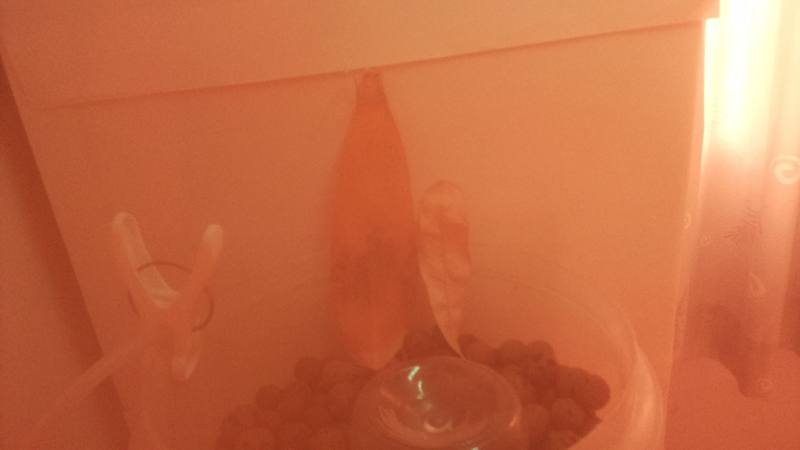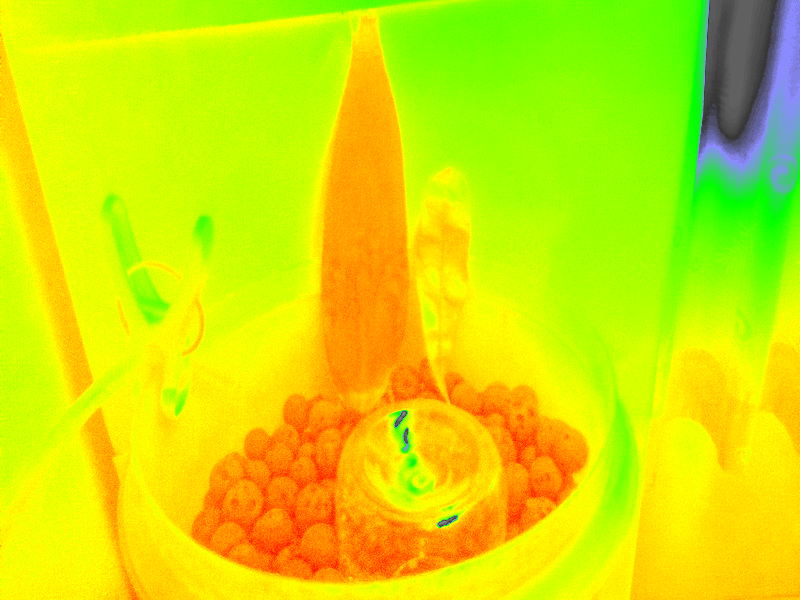I am using Pi NoIR camera with blue filter for my final year project on NDVI image analysis.
I get the concept of the blue filter will block the red light, while leaving most NIR in RED channel while Visible light will be captured in BLUE channel.
However in this case when the red light is blocked by the blue filter, why the image will reddish in color?
I cant find any explanation, looking for help! Thanks
Below is the image taken by Pi NoIR camera with blue filter. 
Here is my NDVI image taken in indoor environment under white led light. 
It cant really differentiate the background and the leaf. I have tried using different AWB settings. Any suggestion?
The camera does not know the color of the light that hits a pixel on the sensor. If more photons hit the pixels linked to the red channel than pixels linked to the blue channel, the camera will produce a reddish color. In this case, if the only light hitting the red channel pixels is NIR, the camera will still produce a red color.
Standard computations of NDVI assume that the light illuminating the scene is similar to sunlight in that it has a similar proportion of VIS (blue or red) light to NIR light. NDVI cannot be reliably computed on indoor photos unless the light has a spectral balance of VIS and NIR similar to sunlight.
Chris
Does it means if I use red filter instead and captured the NIR from blue channel, my image will show blue colour as the light is hitting on the blue channel?
My original plan to carry out NDVI analysis was in outdoor environment, however due to covid-19 I am forced to move my system indoor which I use white LED light (limited source at home haha) to replace the visible light emit by the sunlight (I wonder is my approach correct).
Can you give your opinion on my NDVI image result? Does it looks okay for you? I actually use one healthy leaf (left) and one unhealthy leaf (right, smaller) to show the difference. I increase red gains so it will be more obvious.
I am following the post on https://publiclab.org/notes/petter_mansson1/04-09-2019/low-cost-ndvi-analysis-using-raspberrypi-and-pinoir for my project. It seems like his project is carried out in indoor environment too.
Thanks for your help!
Is this a question? Click here to post it to the Questions page.
With a red filter, photos will be bluish if the blue channel (which is used for NIR) is brighter than the red channel (which is used for VIS). For healthy foliage there should be about three times more NIR than red light reflecting from leaves, so foliage should look blue.
The light used to illuminate the plants for photography must include a lot of NIR or else meaningful NDVI will not be possible. Your white LEDs may or may not include lots of NIR. It is not necessary to grow the plants with NIR light -- the plants do not use it and leaves reflect most of it. That is why NDVI works. When you take a photo to learn about plant health by computing NDVI, there must be lots of NIR illuminating the plants. If not, the light recorded in your NIR channel will not be NIR and the NDVI results will be meaningless. So when photography is done, maybe turn on lots of NIR LEDs that are as bright as the white LEDs.
It is not possible to evaluate your NDVI image because you did not include any information about what the different colors mean.
The note you linked to does not mention anything about how they illuminated the plants during photography so it is not possible to evaluate the validity of the results.
Chris
Reply to this comment...
Log in to comment
Assuming your blue filter is transparent to NIR (near infrared) wavelengths, any red in the image is depicting NIR reflection. The blue filter will transmit visible wavelengths but only in the blue portion of the spectrum (green and red are absorbed by the filter). So your image should be depicting NIR as recorded by the red pixels
and Blue as recorded by the blue pixels. Green objects (not vegetation) should be quite dark. These are the transmitted/absorbed wavelengths before NDVI modifications are made.
Hope that helps.
On Fri, Jun 5, 2020 at 9:22 AM \<notifications@publiclab.org> wrote:
Is this a question? Click here to post it to the Questions page.
Hi there! Ya I did get the idea from your comment and thanks!
Just to reconfirm the concept, so if I use red filter instead, it will absorb green and blue light, in which in this case I have to capture NIR value in blue channel, hence my image will show in blue color?
Can you give your opinion on my result? Does it look promising? I was using one healthy leaf (left, bigger) and one unhealthy leaf to show the difference.
Thanks for your help again. You enlighten me :)
Is this a question? Click here to post it to the Questions page.
Hi @wangmeising97 , i think the key is to go outside to take your pictures -- you need all that infrared light from the sun to reflect off the leaves so that the health difference really shows.
Reply to this comment...
Log in to comment